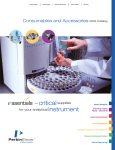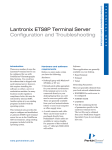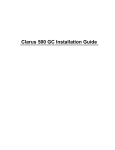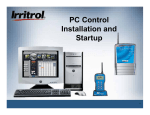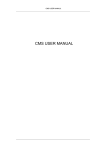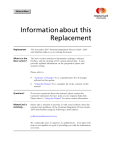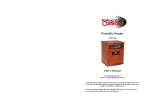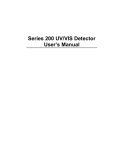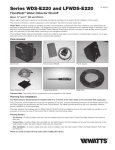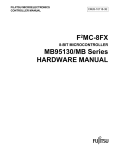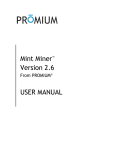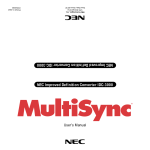Download Series 200 Oven Family
Transcript
LIQUID CHROMATOGRAPHY SERIES 200 OVEN FAMILY User’s Manual Series 200 Oven Family User’s Manual Release History Part Number 09936398 Release D Publication Date October 2003 Any comments about the documentation for this product should be addressed to: User Assistance PerkinElmer 710 Bridgeport Avenue Shelton, Connecticut 06484-4794 U.S.A. Or emailed to: [email protected] Notices The information contained in this document is subject to change without notice. Except as specifically set forth in its terms and conditions of sale, PerkinElmer makes no warranty of any kind with regard to this document, including, but not limited to, the implied warranties of merchantability and fitness for a particular purpose. PerkinElmer shall not be liable for errors contained herein for incidental consequential damages in connection with furnishing, performance or use of this material. Copyright Information This document contains proprietary information that is protected by copyright. All rights are reserved. No part of this publication may be reproduced in any form whatsoever or translated into any language without the prior, written permission of PerkinElmer, Inc. Copyright © 2003 PerkinElmer, Inc. Produced in the USA. Trademarks Registered names, trademarks, etc. used in this document, even when not specifically marked as such, are protected by law. PerkinElmer is a registered trademark of PerkinElmer, Inc. Contents Safety and Regulatory Information Electromagnetic Compatibility (EMC) ..........................................S-1 United States...........................................................................S-1 Addresses........................................................................................S-1 Conventions used in this Manual ..................................................S-2 Instrument Symbols and Warnings...............................................S-2 Symbols....................................................................................S-2 Warnings on the Oven.............................................................S-4 Electrical Warnings........................................................................S-6 Quality Control/Good Laboratory Practices ..................................S-7 Quality Control ........................................................................S-7 Certificate of System Control..................................................S-7 Instrument Performance Verification (IPV) ...........................S-7 Routine Inspection and Suitability Test .................................S-7 Hazardous Chemicals.....................................................................S-8 Definitions in Warning for Hazardous Chemicals .................S-8 Temperature, Humidity and Environment ...................................S-9 Storage Conditions ..................................................................S-9 Introduction About the Manual...........................................................................1-1 Chapter Content ......................................................................1-1 Introducing the Series 200 Peltier Column Oven .........................1-2 About the Oven Controls, Indicators, and Connections .........1-5 Warranty Exclusions and Limitations...........................................1-7 Maintenance ...................................................................................1-7 Warnings and Precautions .............................................................1-7 Solvents....................................................................................1-7 Buffers......................................................................................1-8 Corrosion..................................................................................1-8 Air Bubbles ..............................................................................1-8 Pressure Buildup .....................................................................1-9 Specifications ..................................................................................1-10 -i- Contents Installing the Oven Prepare Your Laboratory ...............................................................2-1 Required Air Quality ...............................................................2-1 Sufficient Electrical Power......................................................2-2 Space Requirements ................................................................2-2 Solvents/Mobile Phase.............................................................2-2 Unpack Your Series 200 Peltier Column Oven .............................2-3 Electrical Requirements and Settings ...........................................2-3 Oven Power Cord and Fuses ...................................................2-4 AC Line Cord ...........................................................................2-5 Connect the Tubing ........................................................................2-6 Turn-On the Oven ..........................................................................2-7 Using the Column Oven Operating Overview .......................................................................3-1 Operating Summary.......................................................................3-2 Shutting Down the System ............................................................3-2 Appendix Series 200 Accessory Control Installation Guide - ii - Safety and Regulatory Information Electromagnetic Compatibility (EMC) United States This product is classified as a digital device used exclusively as industrial, commercial, or medical test equipment. It is exempt from the technical standards specified in Part 15 of the FCC Rules and Regulations, based on Section 15.103 (c). Addresses To obtain assistance with the Series 200 Peltier Column Oven, contact the Company as described below: User Assistance PerkinElmer 710 Bridgeport Avenue Shelton, Connecticut 06484-4794 Tel: (800) 762-4000 Fax: (203) 762-6000 Supplies, accessories, and replacement parts can be ordered directly from PerkinElmer using the eight-digit part numbers provided in the manual. To place an order or ask for information, call your local PerkinElmer representative. S-2 Safety and Regulatory Information Conventions used in this Manual Conventions used in this Manual The following graphic symbols and special text formats are used in this manual to identify important safety information: A warning indicates an operation that could cause personal injury if precautions are not followed. A caution indicates an operation that could cause instrument damage if precautions are not followed. Note Notes emphasize significant information in a procedure or description. Instrument Symbols and Warnings Symbols The following three types of warning symbols appear on the instrument: This symbol indicates an operation (or instrument condition) that could cause personal injury if precautions are not followed. This can be any type of hazard. When you see this symbol, refer to the safety pages in the manual for further information. Consulter les documents d’accompagnement. This symbol indicates the danger of electric shock if precautions are not followed due to the presence of high voltage. Attention. Risque de choc électrique. This symbol indicates the danger of burns if precautions are not followed due to the presence of heat in this instrument area. This may also indicate a hot surface that can be easily touched. AVERTISSEMENT. Surface chaude. Safety and Regulatory Information Instrument Symbols and Warnings The following additional graphic symbols used on the instrument: S-3 S-4 Safety and Regulatory Information Instrument Symbols and Warnings Warnings on the Oven The following warning labels are affixed to the side and rear panels of the column oven: See Figures S-1 and S-2. 30.0 3 1.0 Figure S-1. Location of side panel warning labels on the Series 200 Peltier Column Oven. Safety and Regulatory Information Figure S-2. Instrument Symbols and Warnings Location of the rear panel warning labels on the Series 200 Peltier Column Oven. S-5 S-6 Safety and Regulatory Information Electrical Warnings The following information is printed on a warning label that covers the fuse receptacle on the rear panel of the oven: The Series 200 Peltier Column Oven is shipped from the factory with: - the operating voltage set to 240 VAC. - the main AC power switch set to the OFF position. - 2.0 amp fuses installed. If your line voltage is 110/120 volts, you need to switch the voltage selector setting to 110 or 120 and install the 4.0 amp fuses before installing the line cord and turning on the AC power. Electrical Warnings Electrical Hazard: Connect the instrument to an AC line power outlet that has a protective ground connection. To ensure satisfactory and safe operation of the instrument, it is essential that the protective ground conductor (the green/yellow lead) of the line power cord be connected to a true electrical ground. Any interruption of the protective ground conductor, inside or outside the instrument or disconnection of the protective ground terminal may impair the protection provided by the instrument. Electrical Hazard: Do not operate the instrument with any covers or parts removed. Electrical Hazard: Do not make adjustments, replacements or repairs to this instrument except as described in the User Documentation. Only a PerkinElmer service representative or similarly trained and authorized person should service the instrument. Electrical Hazard: Use only fuses of the specified type and with the required current rating for replacement. Safety and Regulatory Information Quality Control/Good Laboratory Practices S-7 Quality Control/Good Laboratory Practices Quality Control The user should develop appropriate quality control procedures for the LC Peltier Column Oven (and the entire LC system) to ensure suitability for its intended use. These procedures typically consist of periodic performance verifications and routine inspections and suitability tests. Certificate of System Control Each Series 200 Peltier Column Oven is carefully built and tested in a controlled system in accordance with the requirements specified in its applicable PerkinElmer Final Assembly and Test Specification. Each instrument is certified to meet its functional and performance specification upon release to shipment. The integrity of this quality system is routinely audited and is certified by the British Standards Institution as meeting all requirements of ISO 9001:1987 (Certification No. FM 22179). Instrument Performance Verification (IPV) To maintain functional performance, PerkinElmer recommends a yearly Instrument Performance Verification (IPV) of the Series 200 Peltier Column Oven by a PerkinElmer Service Engineer to ensure its operation within published specifications. These tests consist of measuring the most important Peltier Column Oven characteristics, such as retention time repeatability. Certification is available for regulatory compliance. Contact your local Perkin-Elmer Sales and Service office. Routine Inspection and Suitability Test To ensure that the LC system is operating within established criteria (for example, peak resolution, peak asymmetry, precision, retention time, column plate count, pressure limits, signal/noise ratio, etc.), perform a system suitability test (which closely resembles the intended assay) prior to running a sample analysis with the Series 200 Peltier Column Oven in the LC system. While the Universal Test Mix (UTM) P/N 0089-0893 can be used for a system check, we recommend that you develop a separate system suitability test and acceptance criteria for each of your assays. S-8 Safety and Regulatory Information Hazardous Chemicals Hazardous Chemicals Before using mobile phase solvents, you should be thoroughly familiar with all hazards and safe handling practices. Observe the solvent manufacturer’s recommendations for use, storage, and disposal. These recommendations are normally provided in the material safety data sheets (MSDS) supplied with the solvents. Some chemicals used with this instrument may be hazardous or may become hazardous after completion of an analysis. The responsible body (for example, the Lab Manager) must take the necessary precautions to ensure that the surrounding workplace and that the instrument operators are not exposed to hazardous levels of toxic substances (chemical or biological) as defined in the applicable Material Safety Data Sheets (MSDS) or OSHA, ACGIH, or COSHH documents. Venting for fumes and disposal of waste must be in accordance with all national, state and local health and safety regulations and laws. Definitions in Warning for Hazardous Chemicals Responsible body: “Individual or group responsible for the use and maintenance of equipment, and for ensuring that operators are adequately trained.” [per IEC 1010-1, Amendment 2 ]. Operator: “Person operating equipment for its intended purpose.” [per IEC 1010-1, Amendment 2 ]. OSHA: Occupational Safety and Health Administration (United States) ACGIH: American Conference of Governmental Industrial Hygienists COSHH: Control of Substances Hazardous to Health (United Kingdom) Safety and Regulatory Information Temperature, Humidity and Environment S-9 Temperature, Humidity and Environment This instrument is designed for indoor use only. This instrument is not designed for operation in an explosive environment. Safe Operation This instrument will operate safely between +5°C and +40°C (40°F and 104°F) with an ambient relative humidity of between 20 and 80% noncondensing Installation Category This instrument is able to withstand transient overvoltage according to Installation Category II as defined in IEC 1010-1. Pollution Degree This equipment will operate safely in environments that contain nonconductive foreign matter up to Pollution Degree 2 in IEC 1010-1. Storage Conditions The Series 200 Peltier Column Oven may be stored under the following conditions: • Ambient temperature is -20°C to +60°C (−68°F to +140°F) • Ambient relative humidity is 20% to 80% noncondensing • Altitude is in the range 0 to 12,000 m. Introduction About the Manual............................................................................................................ 1-1 Chapter Content ........................................................................................................ 1-1 Introducing the Series 200 Peltier Column Oven............................................................ 1-2 About the Oven Controls, Indicators, and Connections ........................................... 1-5 Warranty Exclusions and Limitations............................................................................. 1-7 Maintenance .................................................................................................................... 1-7 Warnings and Precautions............................................................................................... 1-7 Solvents..................................................................................................................... 1-7 Buffers ...................................................................................................................... 1-8 Corrosion .................................................................................................................. 1-8 Air Bubbles............................................................................................................... 1-8 Pressure Buildup....................................................................................................... 1-8 Specifications ................................................................................................................ 1-10 Introduction About the Manual This manual contains important information regarding potential hazards that may arise during the operation of the Peltier column oven. All references, except where indicated in this manual, that refer to the Series 200 Peltier Column Oven also apply to the Series 200 Column Oven. It is essential that the Safety and Regulatory Information preceding this chapter be read and thoroughly understood by all potential users of the oven. The Peltier column oven should be used according to the instructions provided in the manual. If used otherwise, the protection provided by the Peltier column oven may be impaired. Chapter Content In the first chapter of this manual we describe the Series 200 Peltier column oven and its controls. In the second chapter we describe installation of the oven in your LC system. Electrical requirements and tubing connections are also included in Chapter 2. In the third chapter we include principles of operation for the oven, routine operating procedures, and the procedure for shutting down the system. This manual is written for a person who has developed a working knowledge of liquid chromatography and understands: • The function of each major component in a liquid chromatography system. • How to select a column based on the analysis you wish to perform. • The principles of solvent selection and sample preparation. 1-2 Introduction Introducing the Series 200 Peltier Column Oven If you require an introduction to these concepts, the following book is an excellent reference: Practical Liquid Chromatography -- An Introduction by R.W. Yost, L.S. Ettre, and R.D. Conlon, published by The Perkin-Elmer Corporation (1980), P/N 09939656. Introducing the Series 200 Peltier Column Oven The Series 200 Peltier Column Oven controls the column temperature; variations in column temperature can cause significant changes in retention times. The oven provides controlled temperatures which aid analyses by decreasing mobile phase viscosity and increasing mass transfer and sample solubility. The oven also provides cooling, i.e. the capability of controlling the oven temperature in the 10 to 25 °C region. The major features of the Peltier Column Oven include the following: • A low-dispersion heat exchanger which heats the mobile phase and sample before it enters the column. The injected sample remains a plug as it passes through the heat exchanger, which prohibits peak broadening. Because of this solvent preheating technique, the mobile phase encounters a stationary phase of uniform temperature over the entire length of the column. • An open-bed design which eliminates the need for specific blocks or inserts for different column sizes. Up to three 3/8-in.× 30 cm or three ¼-in.× 30 cm HPLC columns can be easily placed inside the column oven. The column oven chamber is large enough to accommodate a guard column and an analytical column for precise temperature control. • The Peltier Column Oven can be operated either manually or remotely via an RS232C port. • A leakage sensor is included in the column oven. If a leak occurs, a red light on the front panel illuminates. This feature protects against potential hazards and oven damage. • The anodized aluminum column chamber (see the top illustration in Figure 1-1) is corrosion resistant. It is light, strong, and enhances temperature uniformity. Introduction Introducing the Series 200 Peltier Column Oven 1-3 You can install your column by simply removing the lower part of the front panel (which is held onto the oven assembly only by magnets), connect the fittings to the column inlet and outlet, and insert the column into the holders to secure it in place. Figure 1-1. Front View of the Series 200 Peltier Column Oven. (The top drawing shows the column chamber after removing the front panel.) 1-4 Introduction Introducing the Series 200 Peltier Column Oven The column chamber contains a drain line that directs solvent leaks away from the electronics. Connect drain tubing to the drain fitting located under the left-front panel of the Peltier Column Oven (see Figure 1-2), and directs the tubing to the system waste vessel as shown in Figure 2-4. Take care not to crimp the drain tubing. Since you can access the column chamber from the front, the Series 200 Peltier Column Oven can be stacked with other system modules, such as the Series 200 pump, detector, autosampler, etc. (see Figure 2-1). Also, when using this stacked configuration, band broadening is reduced by keeping the tubing from the pump to the column and/or from the column to the detector to a minimum. Figure 1-2. Front view of the column chamber showing the column inlet and outlet fittings. The oven is controlled via a general-purpose temperature programmer (see Figure 1-3). The keys and LED displays on the programmer (controller) are discussed below: • Top (Green) display continuously shows the current oven temperature in °C. • Bottom (Red) display shows the stored oven temperature setpoint in °C. • and keys lower and raise, respectively, the column oven temperature. Introduction Introducing the Series 200 Peltier Column Oven • key for Service use only. • key resets solvent leak alarm. 1-5 Figure 1-3. Peltier Column Oven controller. About the Oven Controls, Indicators, and Connections On the Front Panel • Oven Controller: (see Figures 1-1 and 1-3). Used to increase and decrease the oven temperature. • and • key: For service use only. keys: Used to lower and raise, the oven temperature. • Alarm Reset Button – reset solvent leak alarm. • Column Inlet/Outlet Fittings: (see Figures 1-2 and 2-4). Standard fittings which accept 1/16-in. tubing for connection to the column inlet and detector. • Column Drain: Directs leaks away from the column chamber to a fitting under the left-front panel of the oven (see Figure 1-2). Connect one end of a length of 1/8-in. tubing and place the other end in a waste vessel (see Figure 2-4). 1-6 Introduction Introducing the Series 200 Peltier Column Oven On the Back Panel Figure 1-4. Back panel of the Peltier Column Oven. • Power (On/Off) switch: A rocker-type switch located above the power cord connector. It supplies AC power to the Peltier Column Oven. • Fuse holder: Located between the on/off switch and power cord receptacle it holds the system fuses. The Peltier Column Oven is shipped with two 2-amp fuses installed for 240-Volt operation. Note Two 4.0 Amp slow blow, type T fuses are provided for 120 V operation. Two 2.0 Amp, 240 Vac, Type T, 5 x 20 mm fuses are supplied for those who wish to operate the instrument with 240 V. See Chapter 2, Installing the Oven, for the procedure for installing the fuses and/or changing the line voltage. • Power cord connector (AC input): Accepts the detachable three-prong power cord. • Voltage selector switch: Allows choosing the appropriate line voltage. • RS-232 Connector: Allows control of the Peltier Column Oven by Turbochrom (rev 6.2). Introduction Warranty Exclusions and Limitations 1-7 Warranty Exclusions and Limitations The Limited Warranty set forth on PerkinElmer's ORDERING INFORMATION form applies to the Series 200 Peltier Column Oven. Among those items excluded from the warranty under Part (B) "EXCLUSIONS AND LIMITATIONS" are: • Fuses • Nuts • Ferrules The items listed above are considered to be routinely replaced as part of the normal wear of the instrument. Maintenance Before using any cleaning or decontamination method except those recommended, users should check with the manufacturer to make certain that the proposed method will not damage the oven. Warnings and Precautions Read and understand the following warnings and precautions. Solvents Give careful attention to the hazards associated with the solvents you are using. Refer to the safety data sheets provided by the manufacturer. For example, Material Safety Data Sheets (MSDS) in the USA. • Wear appropriate eye protection at all times when handling chemicals. Use safety glasses with side shields, goggles, or full-face shields, according to the types of chemicals you will be handling. • Wear suitable protective clothing, including gloves that are specifically resistant to the chemicals being handled. • Always use clean solvents. Solvents which have been distilled in glass (HPLC Grade) are highly recommended. • Filter the solvents through a 0.5-micron medium as an additional precaution. • Carefully use and store flammable solvents, which may form hazardous by-products when the instrument is shut down, by following the recommended shutdown procedure. 1-8 Introduction Warnings and Precautions • Check compatibility of solvent(s) with the type of column(s) being used. • Know the relative polarity and miscibility of the solvents being used. Buffers Exercise care when using buffers in conjunction with organic solvents. NEVER LEAVE BUFFERS IN THE SYSTEM OVERNIGHT. Buffers left in the system can form salt crystals, which may cause premature pump seal failure, interfere with proper check valve operation, and plug the connecting tubing or the detector flowcell. To remove buffers, flush the system first with water, then with methanol or isopropanol. Change the mobile phase from methanol or isopropanol to water before using buffers. Corrosion All parts that contact the mobile phase are made of stainless steel, Teflon, PEEK, or glass. Some of these materials are extremely sensitive to acid chlorides. If you have questions about your mobile phase, contact a PerkinElmer representative. Table 1-1. Solvents Which May Corrode the Series 200 Peltier Column Oven Aqua Regia (80% HCl, 20% HNO3 ) Chloride salt solutions* Chlorinated solvents Halogenated solvents Sulfuric Acid (Conc.) * Titanium is more resistant to chloride salt solutions. Air Bubbles To prevent air from entering the system, and to ensure that pressure fluctuations do not occur, observe the following precautions: • Ensure that the pump's solvent inlet filter is below the solvent level in the solvent reservoir. • If the pump has not been used for an extended period of time, remove air bubbles by connecting a priming syringe to the drain valve on the pump, opening the drain valve, and fast-flushing the system to prime the pump. After priming the pump, close the drain valve completely. Pressure Buildup Over time, you may notice a gradual increase in the system operating pressure. If you observe pressure readings greater than 3.45 MPa (500 psi) above the normal operating pressure of your analysis, check the following items: Introduction Warnings and Precautions 1-9 • If you are injecting “clean” samples and there is no other apparent cause for the pressure buildup, remove, disassemble, and clean the injector. • If you are injecting “dirty” samples, the injector may be clogged or the column packing material may have retained contaminated particulates. Remove and clean the injector, and replace the column. • The column end fitting or column frit may be plugged. Replace the end fitting or frit to relieve excess pressure. (Refer to the instructions supplied with the column.) • In-line filters may be plugged. Replace the filter element. • With the pump connected directly to the detector input, if you still experience excessive pressure, the problem could be a plugged flowcell. You can flush, reverseflush, or rebuild the flowcell. 1-10 Introduction Specifications Specifications Table 1-2 – Series 200 Peltier Column Oven, Oven/Selector Specifications Specification Description Column Capacity Up to three 3/8-in. × 30-cm columns or three ¼-in × 30-cm columns Operating Range 5°C to 90°C (39°F to 194°F) Up to 5 mL/minute Recommended Flow Range Temperature Accuracy ± 1°C between 5°C and 90°C* ± 1°C between 10°C and 90°C** ± 2°C between 15°C and 90°C*** Temperature Stability ± 0.2°C (± .36°F) Temperature Repeatability ± 1°C (1.8°F) Heating/Cooling Rates 30 minutes to 10°C (50°F) at 2 mL/min* or 30 minutes to 60°C (140°F) at 2 mL/min* Temperature Ramp Safety Cutoff Stabilizing Time Power Requirements: Power Consumption Line Voltage Operating Range Frequency Line Cord Fuse Rating Characteristics: 120 VAC (P/N 0999-1689) 240 VAC (P/N 0999-1637) Operating Conditions: Ambient Temperature Ambient Relative Humidity (RH) Altitude Storage Conditions: Ambient Temperature Ambient Relative Humidity Altitude Dimensions Weight Up to 5 °C/min (9 °F/min) cooling and heating* Leakage sensor 30 minutes after making setting 120 Watts 110/120/220/240 Vac, 50/60 Hz ±10% (Line voltage is set at the factory to 230 Vac.) 50/60 Hz See “Installing the AC Line Cord” in Chapter 2 4.0 Amp, Type T, 250 Volt 2.0 Amp, Type T, 250 Volt 10 to 35°C (50 to 95°F) 20 to 80% RH (without condensation) 0 to 2000 m -20 to +60°C (-4 to+140°F) 20 to 80% RH (without condensation) 0 to 12,000 m Height: 16.0 cm (6.3 in.) Width: 34.0 cm (13.4 in.) Depth: 48.0 cm (18.9 in.) 9 Kg (20 lb) *With ambient temperatures of between 15°C and 20°C. **With ambient temperatures of between 20°C and 25°C. ***With ambient temperatures of between 25°C and 30°C. Introduction Specifications 1-11 Table 1-3 – Series 200 Column Oven Specifications Specification Description Column Capacity Up to three 3/8-in. × 30-cm columns or three ¼-in × 30-cm columns Operating Range 30°C to 90°C (87°F to 194°F) Up to 5 mL/minute Recommended Flow Range Temperature Accuracy ± 1°C between 30°C and 90°C ± 1.8°F between 86°F and 194°F Temperature Stability ± 0.2°C (± .36°F) Temperature Repeatability ± 1°C (1.8°F) 30 minutes to setpoint at 2 mL/min Heating Rate Temperature Ramp Safety Cutoff Stabilizing Time Power Requirements: Power Consumption Line Voltage Operating Range Frequency Line Cord Fuse Rating Characteristics: 120 VAC (P/N 0999-1689) 240 VAC (P/N 0999-1637) Operating Conditions: Ambient Temperature Ambient Relative Humidity (RH) Altitude Storage Conditions: Ambient Temperature Ambient Relative Humidity Altitude Dimensions Weight Up to 5 °C/min (9 °F/min) heating Leakage sensor 30 minutes at 60°C (140°F for “READY” at 2 mL/min 120 Watts 110/120/220/240 Vac, 50/60 Hz ±120% (Line voltage is set at the factory to 220 Vac.) 50/60 Hz See “Installing the AC Line Cord” in Chapter 2 4.0 Amp, Type T, 250 Volt 2.0 Amp, Type T, 250 Volt 10 to 35°C (50 to 95°F) 20 to 80% RH (without condensation) 0 to 2000 m -20 to +60°C (-4 to+140°F) 20 to 80% RH (without condensation) 0 to 12,000 m Height: 16.0 cm (6.3 in.) Width: 34.0 cm (13.4 in.) Depth: 48.0 cm (18.9 in.) 9 Kg (20 lb) 1-12 Introduction Specifications Installing the Oven Prepare Your Laboratory................................................................................................. 2-1 Required Air Quality ................................................................................................ 2-1 Sufficient Electrical Power ....................................................................................... 2-2 Space Requirements.................................................................................................. 2-2 Solvents/Mobile Phase.............................................................................................. 2-2 Unpack Your Series 200 Peltier Column Oven............................................................... 2-3 Electrical Requirements and Settings.............................................................................. 2-3 Oven Power Cord and Fuses..................................................................................... 2-4 AC Line Cord............................................................................................................ 2-6 Connect the Tubing ......................................................................................................... 2-7 Turn-On the Oven ........................................................................................................... 2-7 Installing the Oven 2 This chapter describes how to install your Series 200 Peltier Column Oven. The topics covered in this chapter are: • Prepare your laboratory • Unpack your oven • Electrical requirements and settings • Connect the tubing • Turn on the oven Prepare Your Laboratory Before installing your Series 200 Peltier Column Oven, prepare your laboratory according to the following guidelines. Required Air Quality To minimize contamination problems, provide a relatively dust-free environment. Make sure that the kinds of gases (or vapors) listed are not present at levels that exceed federal, state, and local ordinances for continuous human exposure: • • • flammable • explosive toxic caustic • corrosive Make sure that your laboratory environment consists of the following temperature and humidity levels: 2-2 Installing the Oven Prepare Your Laboratory • Ambient temperature between 10°C and 35°C (50°F and 95°F) • Constant relative humidity between 20% and 80% (without condensation) Use care when working with hazardous solvents, or solvents that produce hazardous by-products. Solvent vapor levels that are high enough to interfere with the oven performance should be considered hazardous to someone who is continuously exposed to the vapors. Sufficient Electrical Power The Series 200 Peltier Column Oven requires a grounded nominal 120 or 240 Vac source. To prevent degradation of the column oven's performance, the AC line voltage must remain within ±10% of the nominal specified voltage (displayed on the label beneath the line cord). If you experience large voltage fluctuations, install a voltage regulator between the LC system and the wall (power) outlet. Space Requirements The Series 200 Peltier Column Oven is designed to sit on a bench top (or on another module as shown in Figure 2-4). It is plumbed into the LC system between the autosampler and the detector. A space 17 cm (6.7 in.) high is sufficient, as columns are installed from the front of the oven. The oven is 16 cm (6.3 in.) high. See Table 1-2 for all the oven specifications. The case is 34.0 cm (13.4 in.) wide, but additional space is required on each side for the tubing to the column oven. The case is 48.0 cm (18.9 in.) deep, but additional space is required behind the unit to accommodate the power cord which is at the rear of the column oven (see Figure 2-2). Solvents/Mobile Phase Use only HPLC grade solvents in all analyses. HPLC grade water and methanol (1 liter each) are required for performance verification. Installing the Oven Unpack Your Series 200 Peltier Column Oven 2-3 Unpack Your Series 200 Peltier Column Oven Carefully unpack the Series 200 Peltier Column Oven. Then check for obvious signs of damage that may have occurred during shipment. Immediately report any damage or missing items to the shipping carrier and PerkinElmer. A Start-Up Kit is supplied with the oven. Use Table 2-1 to check the Start-Up Kit parts. Table 2-1. Start-Up Kit for the Series 200 Peltier Column Oven Items Included P/N Quantity AC Line Cord* 0998-8986 1 Fingertight Nuts 0992-0513 2 Inlet Union 0990-3289 1 2-Amp Fuses 0999-1637 2 4-Amp Fuses 0999-1689 2 Instruction Manual 0993-6398 1 * Customers located outside the U.S. must order a line cord that is appropriate for their location Electrical Requirements and Settings The Series 200 Peltier Column Oven can operate at 50 or 60 Hz and requires a grounded outlet that provides a nominal 120 or 240 Vac source. If the electrical supply voltage in your laboratory produces large AC line voltage fluctuations, install a voltage regulator between the AC line voltage outlet and your LC system. Instrument grounding is required and accomplished by a third wire in the AC line voltage outlet box. If your electrical outlet does not contain a ground, contact your local electric company. 2-4 Installing the Oven Electrical Requirements and Settings Oven Power Cord and Fuses The AC input power module is located on the left side of the back panel and contains the on/off switch and system fuses. Figure 2-1. Rear panel of the oven. The unit is shipped with two 2.0 amp fuses installed for 240-Volt operation. Prior to operation at 120 VAC, set the operating voltage, and replace the fuses as described below. To replace a blown fuse, proceed as follows (see Figure 2-1): 1. Turn off the AC power to the oven by pressing 0 on the On/Off switch (on the rear of the oven). Then unplug the AC line cord from the AC outlet. 2. To remove a fuse, use a screwdriver to pry the fuse holder from the power input block. 3. Install the appropriate fuse: • • 2 amp fuse (P/N 0999-1637) for 240 volt operation 4 amp fuse (P/N 0999-1689) for 120 volt operation 4. Make certain that the Voltage Selector block is in the correct voltage position. Installing the Oven Electrical Requirements and Settings To change the voltage, proceed as follows (see Figure 2-2): 1. Remove the tan color block by pulling it from the fuse holder. 2. Rotate the block and insert it back into the fuse holder so that the desired voltage displays in the small window in the fuse holder. 3. Install the appropriate fuses in the fuse holder for that voltage (see Figure 2-2). 4. Insert the fuse holder into the Fuse Holder 240 VAC: 2.0 A Fuses (P/N 0999-1637) 120 VAC: 4.0 A Fuses (P/N 0999-1689) Voltage Selector B lock Window Figure 2-2. Removing and installing fuses. 2-5 2-6 Installing the Oven Electrical Requirements and Settings AC Line Cord Do not disconnect or defeat the safety ground on the power cord. Ground is necessary for safe operation of the oven and proper functioning of the electronic circuitry. The line cord should have the electrical rating and proper plug for your location. Figure 2-3 lists the cords with part numbers. To select an AC line cord: 1. Refer to Figure 2-3 and select the proper line cord for your location. 2. Insure that the power switch is off, then plug one end of the line cord into the AC supply. Figure 2-3. AC Outlet configurations. Installing the Oven Connect the Tubing 2-7 Connect the Tubing 1. Use standard 1/16-in. stainless steel or titanium tubing, and standard 1/16-in. nuts and ferrules for all tubing connections you make to the column oven inlet and to the column (see Figure 2-4). Note PEEK tubing (with fingertight connections) can also be used. 2. Connect your 1/8-in. drain tubing to the drain on the left-side of the column chamber and place the other end in the waste container. Turn on the Oven After installing the Peltier Column Oven, read Chapter 3 "Using the Column Oven," before turning it on. 2-8 Installing the Oven Turn on the Oven 30.0 31.0 30.0 31.0 Figure 2-4. Series 200 Peltier Column Oven in a typical LC system. Using the Column Oven Operating Overview ........................................................................................................ 3-1 Operating Summary ........................................................................................................ 3-2 Shutting Down the System.............................................................................................. 3-3 Using the Column Oven In this chapter we explain how to routinely operate the Series 200 Peltier Column Oven. Before operating the oven, carefully read Chapter 2, "Installation," and make a final check of the column connections to and from the oven. We have included a simple paragraph before the operating procedure that explains how the oven works. After the operating instructions, we tell you how to shut down the LC system overnight or for weekends. Operating Overview The Series 200 LC column oven includes: • Front-access column chamber • Open-bed design which accepts different column sizes • Solvent leak sensor • Temperature control via a general purpose temperature programmer The mobile phase and sample from the Series 200 Pump enter the column inlet fitting at the right of the column oven (see Figure 2-1), then pass through a heat exchanger to bring the mobile phase to the column oven set temperature. The specifications of the Series 200 Peltier column oven and Column Oven are included in Tables 1-2 and 1-3. 3-2 Using the Column Oven Operating Summary Operating Summary Make sure that the oven AC line cord is connected to the proper line voltage. See the paragraphs "Electrical Requirements" and "Setting the Operating Voltage" in Chapter 2. After switching on the oven power, proceed as follows: 1. Set the oven temperature by pressing the – and •s keys. 2. Red is the set temperature and green is the actual. Figure 3-1. Peltier Column Oven controller. Using the Column Oven Shutting Down the System 3-3 Shutting Down the System When shutting down the system overnight or for the weekend, observe all precautions pertaining to hazardous solvents and/or those solvents which form harmful deposits or by-products. 1. Remove harmful mobile phases from the LC system. 2. Flush the column according to the instructions supplied with the column. Flush buffer salts from the system with water; evaporation leaves salt crystals which may form harmful deposits. Remove chloroform or solvents which can decompose to form hydrochloric acid from the system. Damage caused to the system by precipitating buffer salts in capillary tubing, or damage resulting from this condition, is specifically excluded from warranty. 3. After removing harmful mobile phases, prepare the detector for most mobile phases by flushing it with isopropanol. To avoid contaminating the system, re-filter or discard solvents (including water) that were exposed to the environment for more than 24 hours before use. 4. For weekend storage we recommend flushing 60%/40% MeOH/Water through the pump, column, and flowcell (provided your column is compatible with MeOH/Water). Then turn off the column oven, pump, and detector. 3-4 Using the Column Oven Shutting Down the System Appendix Series 200 Accessory Control Installation Guide Page 1 of 6 Series 200 Accessory Control Installation Guide 1. Requirements 1.1 Software Requirements • • PerkinElmer Series 200 Accessory Control software PerkinElmer Turbochrom 6.1.2 or TotalChrom 6.2 Workstation (WS) or Client/Server (CS) software 1.2 Hardware Requirements • • PerkinElmer Series 200 Peltier Column Oven (Part number: N260-1580) or Series 200 Accessory Controller Rheodyne LabPRO 6-Column Selector Rheodyne Part numbers: PR501-104-01 (Stainless Steel) or PR551-104-01 (PEEK); previously purchased as “Special” through PerkinElmer 1.3 Terminal Server Connection If a Terminal Server is used to connect the modules the following hardware is required: • • • • 8-port Lantronix Terminal Server: Part number S200-0062; Note: The older terminal servers require a Transceiver, Part number S200-0009 Corresponding adapter(s) supplied in Series 200 Accessory Control Kit. An RJ12 cable for each module. Part numbers: 7ft. / 2m: S501-0037 25ft. / 7m: S501-0038 50ft. / 15m: S501-0039 100ft. / 30m: S501-0040. An RJ45 cable to connect the Terminal Server to the network. Contact Lantronix for available cables. 1.4 Serial Port Connection If the modules are connected via the computer’s serial ports the following hardware is required: • • • • 9-pin Com (serial) port(s) must be available on the computer. A RS-232 modem cable (25-pin male to 9-pin female) for each oven; supplied with each column oven A Null-modem 25-pin RS-232 cable (Rheodyne part number 5123-067) for each column selector; purchased as “Special” through PerkinElmer. For column selector: Standard 9-pin computer serial ports require 25-pin (male) to 9-pin (female) converter – from any computer store Page 2 of 6 The following should be completed in conjunction with the Series 200 Accessory Control Installation Checklist : 2. Hardware Installation: 2.1 Column Oven Install the column oven, including power cable (see Installation section in the PerkinElmer Instruments Series 200 Peltier Column Oven (or Series 200 Accessory Controller) User’s Guide. If the column oven is connected via a serial port on the local computer, install the RS232 modem cable supplied with the oven, connecting the oven to the computer. If a Terminal Server is used to connect the column oven, install the corresponding adapters and RJ12 cables to connect the module to the Terminal Server (see below). 2.2 Column Selector Install the column selector, including power cable. (Not necessary if part of Series 200 Accessory Controller; proceed to next paragraph) Important Note: Proceed in the following order: first power on the column selector and then connect the RS-232 / Terminal Server cable. This is especially important if the other end is already connected to active computer port / Terminal Server. On the Series 200 Accessory Controller, the cable connection for the column selector is made on the back of the unit. If the column selector is connected via a serial port on the local computer, install the Rheodyne RS-232 null-modem cable and adapter (see Requirements above) connecting the oven to the computer. Install the inlet/outlet/column connections. If a Terminal Server is used to connect the column selector, install the corresponding adapters and RJ12 cables to connect the module to the Terminal Server (see next page). Page 3 of 6 2.3 Terminal Server Connect the Terminal Server to the network and configure the Terminal Server (see Lantronix Terminal Server Installation Guide). It is encouraged to check Terminal Server port parameters for Series 200 Accessory Control. These parameters can be accessed by Telnetting to the terminal server and typing "show ports x”, “x” being the port number to which the device is connected. The parameters should be set as follows: Char Size/Stop Bits: 8/1 Input Speed: Flow Ctrl: None Output Speed: Parity: None Modem Control: Access: Remote Local Switch: Backward: None Port Name: Break Ctrl: Local Session Limit: Forward: None Terminal Type: Preferred Services: (Lat) (Telnet) Authorized Groups: 0 (Current) Groups: 0 Characteristics: Loss Notify Remote Conf 9600 9600 None None Port_1 4 Soft() 2.5 General Ensure that the relevant computers, the terminal server, if available, the column oven and column selector, interfacing hardware, the HPLC system, and the printer are turned on. Page 4 of 6 3. Software Installation 3.1 Server Application (Server and Client Application) 1) It is recommended that one install the server application on the same computer on which the Turbochrom / TotalChrom (TC) Server is installed. In the Series 200 Accessory Control Configuration Checklist, enter the name of the server on which Series 200 Accessory Control server application will be installed. The Configuration Checklist is located on the installation CD or in section III of the Appendix within the Series 200 Accessory Control IQOQ. Note: On a Client/Server system, install the server application once, on only one computer. 2) To install the Series 200 Accessory Control software log on as a Windows administrator. 3) Run the Setup.EXE on the installation CD. 4) Follow the instructions on the Welcome screen. 5) On the Installation Type screen select to install the “Server and Client Applications”. Note: To install the Server component, Windows NT 4 (Service Pack 5) or higher is required. 6) On the Server Account screen enter the “Domain\Account”. This should refer to the Turbochrom / TotalChrom TCProcess account which must have administrative rights. Enter the account’s password and password confirmation. 7) On the Destination Location screen the following default directory is selected: “C:\Program Files\PerkinElmer\Series 200 Accessory Control” or select the “Browse” button to select another destination folder. 8) On the Backup Replaced Files screen it is recommended to create backups of replaced files. By default the following directory is selected: “C:\Program Files\PerkinElmer\Series 200 Accessory Control\BACKUP”. If in the previous dialog (step 7) another destination folder has been selected, the BACKUP folder will be created in the appropriate destination folder. 9) On the Select Program Manager Group screen a program manager group is entered by default (PerkinElmer\Series 200 Accessory Control). If desired enter another program manager group. Note: With the selected program manager group, on NT any user has access to this program. 10) On the Start Installation screen select “Next” to install the program. 11) The program will be installed. Note: During installation a computer restart might be required if newer system components have to be installed. After the restart, the same login has to be used. After the computer restart, the installation process will start from the beginning. Reenter the original entries. 12) When the Installation Complete screen appears the installation is finished. Selecting the “Finish” button will complete the Installation program. 13) After the installation, the system has to be restarted. If an immediate restart is desired, select “OK” in the Install dialog or select “Cancel” to return to Windows and restart the system later. Page 5 of 6 3.2 Client Application 1) The Client application has to be installed separately on each computer on which a Series 200 Accessory Control application is desired. Turbochrom / TotalChrom has to be available on each of these client computers. 2) To install the Series 200 Accessory Control software log on as a Windows administrator. 3) Run the Setup.EXE on the installation disk. 4) Follow the instructions on the Welcome screen. 5) On the Installation Type screen select to install the Client Application only. 6) On the Server Name screen the Server name is entered by default. Note: If no entry or an incorrect server name entry is present, enter the name of the server on which the Server Application has been installed (see Server Application Installation, step 1). 7) Complete the Client Installation by continuing with step 7 of the Server Application Installation. 4. Required Turbochrom / TotalChrom System Configuration Changes In order to have access to the Series 200 Accessory Control software from the Turbochrom / TotalChrom Navigator’s Apps menu the following changes in the System Configuration are required. For every “Job Type” using PerkinElmer Series 200 Accessory Control software the following procedures have to be completed under Turbochrom’s / TotalChrom’s SysConfig. 4.1 For administrator accounts: 1) Open SysConfig and select the Job Types tab. 2) Select Job Type to be changed. For TC administrators, this is typically manager. 3) Select the ’Navigator Apps. Menu’ button. 4) Select the ‘New Document’ icon and enter the following menu text: Series 200 Accessory Control Hands-On. 5) Next, using the ‘Folder’ icon, select Hands-On.exe from the directory C:\Program Files\PerkinElmer\Series 200 Accessory Control (or wherever installed via step 7 in section 3.1, above). 6) On the ‘Job Types’ tab select the ‘User Program Access’ button. 7) Verify that this job type has access to all user programs (1st option). Page 6 of 6 4.2 For user accounts: 1) Now select the Job Types for the other users of the software. Note: Steps 2 – 7 must be performed for all job types representing users intending to use Series 200 Accessory Control Hands-On. 2) Select the ‘Navigator Apps. Menu’ button. 3) Select the ‘New Document’ icon and enter the following menu text: Series 200 Accessory Control Hands-On. 4) Next, as in step 7 of section 3.1, using the ‘Folder’ icon, select Hands-On.exe 5) On the ‘Job Types’ tab select the ‘User Program Access’ button. 6) Select this job type to have access to the following program: “PCcontrol.exe”. (for TotalChrom, enter the following Description: “Automated Series 200 Accessory Control Program”.) 7) Select File > Save and Reconfigure to save the configuration. 5. Series 200 Accessory Control Configuration Note: For the Series 200 Accessory Controller, which incorporates both the column oven and selector into a single hardware module, first configure the oven as a “Series 200 Peltier Column Oven. Then, configure the column selector as the stainless steel (SS) version of the Rheodyne 6-port Column Selector. If a formal IQOQ procedure is required, please refer to Section III of the Series 200 Accessory Control IQOQ document. After the Series 200 Accessory Control software has been installed, the following steps to configure column oven/selector modules and customize manager access rights have to be completed. 1) From the Windows, select Start > Programs > PerkinElmer > Series 200 Accessory Control > Series 200 Accessory Control Manager. (if this structure was customized during installation, please follow customized structure. Then, login to Series 200 Accessory Control Configuration Manager as a “manager” with the default user name and password “manager” / “manager”. From the menu bar select Configuration > Manager Access to open the Manager Access Configuration dialog. Select the ‘Add’ button to add user names and passwords for users with administrative rights in Series 200 Accessory Control. Select to delete the default manager login “manager”. 2) Configure Communication Devices by selecting Configuration > Communication and add communication devices. 3) Select Configuration > Accessory Wizard and run the Wizard to create instruments and configure column ovens and column selectors. Note: Only instruments that are configured in Turbochrom / TotalChrom can be configured in Series 200 Accessory Control. Ensure that the Instrument Key and Name match exactly (SysConfig > Instruments tab). Please refer to the Series 200 Accessory Control Standard Operating Procedure, Manager / Configuration Guide section for a detailed description of the configuration procedure. To place an order for supplies and many replacement parts, request a free e-ssentials catalog or ask for information, visit our website at www.perkinelmer.com The most up-to-date information on part numbers, product brochures, systems modules, spare parts, and application notes are in the PerkinElmer website. Telephone: • U.S. only: Call toll free 1-800-762-4000, 8:30 a.m. to 7 p.m. EST. Your order will be shipped usually within 24 hours. • Worldwide: Call your local PerkinElmer sales or service office. abcdr PerkinElmer 710 Bridgeport Avenue Shelton, CT 06484-4794, U.S.A. Internet: http://www.perkinelmer.com email: [email protected] PerkinElmer is a registered trademark of PerkinElmer, Inc. Part Number: 0993-6398-D


























































